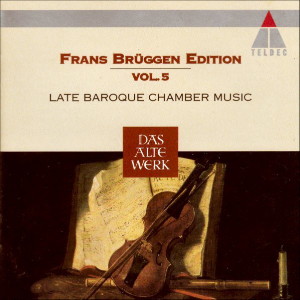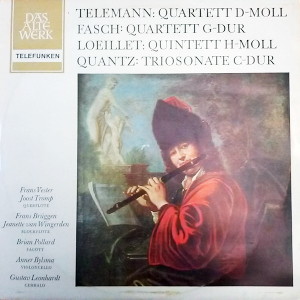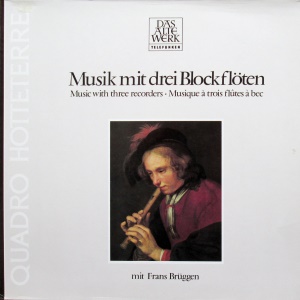 |
|
1 CD -
4509-97467-2 - (c) 1995
|

|
| 1 LP -
SAWT 9464-B - (p) 1964 |
 |
| 1 LP -
6.42365 AW - (p) 1979 |
|
| FRANS
BRÜGGEN EDITION - Volume 5 |
|
|
|
|
|
| EARLY BAROQUE RECORDER MUSIC |
|
|
|
|
|
| Georg Philipp Telemann
(1681-1767) |
|
|
| Quartet
in D minor TWV 43: d1 - two
transverse flutes, recorder and
basso continuo - from "Musique
de table", Vol. II, Hamburg
1733 |
16' 03" |
|
| 1.
Andante |
3'
28" |
|
| 2.
Vivace |
3' 57" |
|
| 3.
Largo |
3' 36" |
|
| 4.
Allegro |
5' 02" |
|
|
|
|
| Johann Friedrich Fasch
(1688-1758) |
|
|
| Quartet
in G major - transverse flute,
two recorders and basso continuo |
8' 48" |
|
| 5.
Andante |
2' 01" |
|
| 6.
Allegro |
1' 46" |
|
| 7.
Affettuoso |
1' 49" |
|
| 8. Allegro |
3' 12" |
|
|
|
|
| Jean Baptiste [John]
Loeillet (1680-1730) |
|
|
| Quintet
in B minor - two transverse
flutes, two recorders ["flauti di
voce", voices flutes] and basso
continuo |
9' 41" |
|
| 9. Largo |
2' 23" |
|
| 10. Allegro |
4' 14" |
|
| 11. Grave |
1' 31" |
|
| 12. Allegro |
1' 33" |
|
|
|
|
| Johann Joachim Quantz
(1697-1773) |
|
|
| Trio
sonata in C major - recorder,
transverse flute and basso continuo |
11' 05" |
|
| 13. Affettuoso |
3' 13" |
|
| 14. Alla breve |
2' 08" |
|
| 15. Larghetto |
2' 46" |
|
| 16. Vivace |
2' 58" |
|
|
|
|
| Alessandro Scarlatti
(1660-1725) |
|
|
| Sonata
in F major - three treble
recorders and basso continuo |
6' 06" |
|
| 17. Adagio |
2'
21" |
|
| 18. Allegro |
2'
48" |
|
| 19. Minuet |
0'
57" |
|
|
|
|
| Johann Mattheson
(1681-1764) |
|
|
| Sonata
IV in G minor - three treble
recorders |
8' 27" |
|
| 20. Prelude:
Adagio |
3'
03" |
|
| 21. Allegro |
2'
39" |
|
| 22. Chaconne |
2'
45" |
|
|
|
|
| Frans Brüggen, recorder |
|
| Frans Vester, transverse
flute (1-16) |
|
| Joost Tromp, transverse
flute (1-16) |
|
| Jeanette van
Wingerden, recorder (1-16) |
|
| Brian Pollard, bassoon
(1-16) |
|
| Anner Bylsma, violoncello
(1-16) |
|
| Gustav Leonhardt,
organ (1-16) |
|
Kees Boeke, recorder
(17-22)
|
|
| Walter van Hauwe,
recorder (17-22) |
|
| Wouter Möller, violoncello
(17-19) |
|
Bob van Asperen,
harpsichord (17-19)
|
|
|
|
|
|
Luogo
e data di registrazione |
|
Doopsgezinde
Kerk, Haarlem (Olanda) - luglio
1979 [17-22]
|
|
|
Registrazione:
live / studio |
|
studio |
|
|
Producer /
Engineer |
|
Heinrich
Weritz [17-22] |
|
|
Prima Edizione
LP |
|
- Telefunken
"Das Alte Werk" - SAWT 9464-B -
(1 LP) - durata 45' 20" - (p)
1964 - Analogico [1-16]
-
Telefunken "Das Alte
Werk" - 6.42365 AW - (1
LP) - durata 39' 49" -
(p) 1979 - Analogico
[17-22]
|
|
|
Edizione CD |
|
Teldec
- 4509-97467-2 - (1 CD) - durata
60' 31" - (c) 1995 - ADD |
|
|
Note |
|
- |
|
|
|
|
Georg Philipp
Telemann was appointed
musical director of
Hamburg's five main churches
in 1721. Apart from his
onerous official duties, he
also pursued a whole series
of other activities, not
least of which was the
active promotion of his own
works, which he printed and
published at his own
expense. His Musique de
table,
a three-part collection of
instrumental pieces scored
for various combinations,
was issued in 1733. It
includes, in Part II,
the present D minor Quartet
for three solo instruments
and continuo (as
alternatives to the
recorder, Telemann suggested
the bassoon or cello).
Whereas all three solo
instruments dispute the
musical line in the opening
movement, the following
movement is cast in the form
of a concerto movement with
extended passages for the
solo recorder. The third
movement contains motifs
reminiscent of the empfindsamer Stil,
while the motoric rhythms of
the final Allegro are
effectively contrasted with
a middle section marked
“cantabile” by the composer.
With its immense variety the
D minor Quartet is rightly
regarded as one of
Telemann’s finest chamber
works. Like the other pieces
included in the present disc
it is notable for the fact
that it is scored for both
recorder and flute.
In Johann Friedrich Fasch’s
G major Quartet, by
contrast, it is the
transverse flute that
dominates, with the two
recorders adding only
occasional interiections (by
preference in parallel
motion). Fasch was court
Kapellmeister in Zerbst
between 1722 and his death
in 1758, and wrote not only
sacred music but also many
instrumental works.
Posterity has had repeated
difficulty in trying to
identify the individual
members of the Loeillet
family many of whom were
instrumentalists and
composers, and to provide a
precise attribution for the
various works that have
survived under their name.
The most famous member of
the family, John
Loeillet, is known to have
settled in London in 1705
and to have made a living as
an oboist and
harpsichordist. With its two
“voice flutes", his B minor
Quintet is the only known
surviving work for this
combination of instruments.
Flutes and recorders merge
effortlessly with each
other. All the instruments
share the same compass and,
by giving preference to
their middle and lower
register, invest the piece
with a dark-hued tonal
character.
In
the course of his musical
studies, Johann Joachim
Quantz learned to master a
whole series of instruments,
including the recorder and
flute. But it was the flute
that became his principal
instrument, since he hoped
that it would provide him
with the best career
opportunities, a decision
that proved well-founded,
when Frederick the Great
offered him a court
appointment on highly
favourable terms- In
Quantz’s Trio Sonata in C
major the two flutes are
treated as equal partners,
entering into virtuoso
rivalry especially in the
final movement.
Alessandro Scarlatti’s F
major Sonata is remarkable
for its combination of
different compositional
techniques, with polyphonic
writing
in the three upper voices in
the opening movement
contrasting with homophonic
textures in the following
Allegro. The Minuet,
finally, is a brief dance
movement over a simple
chordal accompaniment.
Johann Mattheson is
remembered chiefly as a
music theorist and critic.
His G minor Sonata for three
recorders (and no bass) was
published in Amsterdam in
1708 and is notable, above
all, for its final Chaconne
- variations on a simple
theme - that is played by
all the voices in unison at
the beginning and end of the
movement.
Christian
Bothmann
·····
A brief
history of the
recorder
5.
The recorder in the 18th
century
National
styles: the Low
Countries (II)
A remarkable aspect of
Dutch instrument making
in the 18th century is
the large number of woodwind
instruments made at this
time. The profession of
fluyttemaker was
held in high regard and
commensurately well
paid. By the end of his
life, the oboe maker
Hendrik Richters, for
example, was
one of the wealthiest
men in Amsterdam.
When Richard Haka died
in Amsterdam in 1705, he
left behind him a host
of (ex-)apprentices, of
whom the most important
were
Jan Steenbergen, Abraham
van Aardenberg and
Coenraad Rijkel. Jan
Steenbergen
(1676-c.1730) was
active as a woodwind-instrument
maker in Amsterdam from
1692. Among his
surviving instruments is
a treble recorder in the
Frans Brüggen
Collection that is heard
in tracks 17-22. Made of
boxwood with
ivory inlay it is
particularly well
preserved and has a
fully rounded tone. As
with other Baroque
recorders from this
time, it is tuned a
semitone lower than
modern standard pitch.
Born in Amsterdam,
Abraham van Aardenberg
(1672-1717) made not
only recorders but
also oboes and
bassoons. His
surviving recorders
(cf Vol. 3)
are notable for their
unusual arrangement of
the block (or plug)
and labium (i.e., the
sharp edge that
divides the
air-stream), and also
for their peculiar
bore, which produces a
somewhat rustic but
round and penetrating
tone. In this respect
Aardenberg's
instruments are
similar to many of the
recorders made by the
Van Heerde family. Jan
Jurriansz
Van Heerde (1638-1691)
was born in Groenlo
and settled in
Amsterdam in 1663. His
son Albertus and
grandson Jan
followed him into his
profession. There are
seven known surviving
examples of recorders
by the Van Heerde
family (see Vol. 3).
Other makers active in
Amsterdam were Willem
Beukers (father and
son) and Engelbert
Terton. There are
eight surviving
recorders by the
Beukers, including a
descant recorder that
may be heard in Jacob
van Eyck’s Doen
Daphne in Vol.
4. Like Terton’s
instrument, these
descant recorders are
in two sections, with
a double seventh hole.
Engelbert Terton
(1676-1752) was born
in Rijssen and was
granted a patent
allowing him to
practise as a maker of
woodwind instruments
in Amsterdam in 1710.
His recorders, flutes
and oboes were
internationally sought
after. Perhaps his
most remarkable
instrument is a
boxvvood descant
instrument heard in
Vol. 4. Quite apart
from its striking
appearance (it is
decorated with
engraved silver
rings), it produces a
clear, full tone and
has a range of c" - d
””.
Important recorder
makers who were active
outside Amsterdam
include Robert Wijne
(1698-1774) and Joannes
Hyacinthus Rottenburgh
(1672-1765). Wijne's
surviving recorders
(one descant and two
treble instruments
heard in Vol. 3)
have a limited
expressive range in
terms of their attack
and dynamics but make
up for these
limitations with their
exceptionally delicate
and mellifluous tone.
The Rottenburgh family
is the source of much
scholarly confusion.
They appear to have
hailed originally from
Salzburg but were
active in Brussels as
composers, string
players and makers of
woodwind and string
instruments. Joannes
Hyacinthus Rottenburgh
was the father and
uncle of several later
generations of
instrument makers, in
addition to being a
court violinist in his
own right. His
son Godfridus Adrianus
was an organist and made
flutes, oboes, clarinets
and bassoons. Ten
surviving recorders
attributed to the
Rottenburghs (6 treble,
2 tenor and 2 bass, one
of which is heard in
Vol. 1) were probably
made by Joannes
Hyacinthus.
Peter
Holtslag
Translation:
Stewart Spencer
|
|